http://bit.ly/ux-xr-everyday-vrscifest
How technology can help us to stay connected despite any crises?
How can we create meaningful scientific and artistic projects without being able to be close to each other?
Enactive Virtuality Research Group, Tallinn University
Publications, journals, academic disseminations
http://bit.ly/ux-xr-everyday-vrscifest
New dates for the 8th ECREA conference: 6-9 September 2021
Dear ECC 2020 conference applicants, dear ECREA members,
We would like to inform you that in consultation with the Local Organising Committee, the ECREA Executive Board has approved new dates for the 8th European Communication Conference: 6-9 September 2021. The conference was scheduled for 2-5 October 2020 but we had to make the uneasy decision to postpone. The different timelines and strategies of gradual withdrawal of pandemic prevention measures adopted by individual European countries have made it impossible to organise the event according to our standards of academic quality and hospitality.
The conference calendar will be revised and new important dates will be announced in the conference website.
We are looking forward to seeing you in Braga from the 6 to 9 September 2021.
The submission: ECC20-1152 title Addressing loneliness by means of enacted co-presence in XR has been accepted to the 8th European Communication Conference to be held in Braga, Portugal, October 2-5, 2020.
Braga, Portugal ECC Abstract submitted tikka et al.
| Addressing loneliness by means of enacted co-presence in XR | |
| Authors |
Pia Tikka1, Gholamreza Anbarjafari Shahab2, Doron Friedman3, Sergio Escalera4, Mauri Kaipainen5. 1University of Tallinn / BFM / MEDIT, Enactive Virtuality Lab, Tallinn, Estonia. 2University of Tartu, Intelligent Computer Vision iCV Lab, Tartu, Estonia. 3The Interdsiciplinary Center Herzliya, Sammy Ofer School of Communications / Advanced Reality Lab, Herzliya, Israel. 4University of Barcelona, Dept. Mathematics and Informatics / Computer Vision Center, Barcelona, Spain. 5Perspicamus Ltd, Company, Helsinki, Finland. |
| Abstract Text |
The very nature of the human species is social. Loneliness correlates with mental and physical ill-being within, for instance, the elderly, or people with disabilities, or other conditions causing reduced life-environment. Simultaneously, an increasing trend in the European lifestyle is to outsource taking care of such members of family into the hands of professional social and medical care. Yet, in the light of recent studies, loneliness can be considered a fatal condition. Loneliness reduces the ability to improve one’s life-conditions, motivation of taking care of one’s health, and affects negatively the functions of society. As an indication of the urgency of the matter, UK has even appointed a Minister of Loneliness. The issue dictates the need to figure out all plausible ways to fight loneliness. While human company must be the primary solution, other solutions must be considered to provide socio-emotional comfort to those who suffer of the lack of human accompaniment.
We propose storytelling and narratives as the key component of satisfactory social interaction. Stories told provide supportive structures for maintaining one’s identity and connectivity as part of the world. This talk takes a look at the intriguing question, whether advanced audiovisual technologies which allow immersive interactive experiences within virtual narratives, in some form, might contribute to relieve this sore issue. To emphasize, immersive technologies, here, VR/AR/XR, cannot as such provide fully satisfactory solutions for complex human issue of loneliness. However, as a range of solutions for socially assistive robot technologies have already been proposed by others, it may be appropriate to balance the so far technology-dominated discussion with the deeply human approach of storytelling. The talk outlines efforts to combine the art of interactive audiovisual storytelling with already existing advanced technologies to explore the interconnections between loneliness and technology. It discusses empowering solutions to loneliness, while being mindful of technological determinism. ECREA’s Executive Board and the Local Organizing Committee of the 2020 ECC in Braga are closely monitoring the rapidly evolving COVID-19 pandemic as we are concerned about the health and well-being of our members and conference attendees. The conference dates (2-5 October, 2020) remain unchanged at the present time but we wish to announce changes to the deadline for the acceptance of invitations and the registration period to take account of this period of uncertainty and give you more time to make decisions about attendance. We would greatly appreciate it if you could log in through the link below and confirm or decline the presentation of your paper at the conference. The new deadline for your decision is June 15, 2020. Registration will open on June 15, 2020 and the early bird registration will be correspondingly extended. To reiterate, our intention at present is to go ahead with the physical conference in October but we will review this on an ongoing basis as well as engaging in contingency planning. We are not contemplating a virtual conference as an alternative to the physical conference. Please take care of yourself, your family and your loved ones. Further updates will follow in due course. ABSTRACT REVIEW RESULTS: Link: https://www.czech-in.org/cmPortalV15/Portal/ECC20/normal
|
Paper Presentation accepted to NECS conference – Postponed 2021 (covid-19)
Panel members: Ian Christie, Ana Olenina, Julia Vassilieva, Pia Tikka
Conference cancelled due to cover-19.
The presentation on “Narrative Sense-Making – A Neurocinematic Approach” was part of a Creative Media and Practice Cluster Event, 7 November, 2019, at Shaw Tower, HKBU campus.
The Oxford Handbook of Screendance Studies has been awarded the 2018 Oscar G. Brockett Book Prize for Dance Research by The Dance Studies Association.
Pia Tikka & Mauri Kaipainen contributed with the chapter on “Screendance as Enactment in Maya Deren’s At Land: Enactive, Embodied, and Neurocinematic Considerations”
The award will be conferred at the annual Dance Studies Association Conference at Northwestern University, August 8 – 11, 2019.
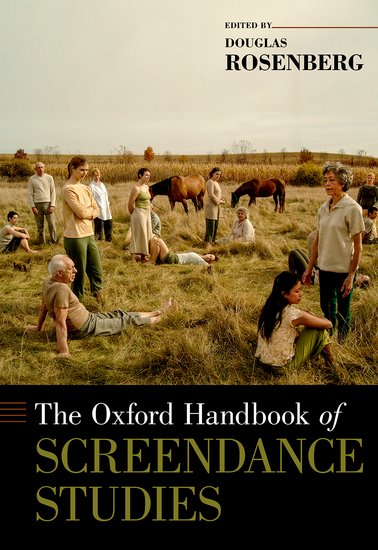
The following is the citation offered by the selection committee about the book:
The Oxford Handbook of Screendance Studies, which is skillfully edited by Douglas Rosenberg, features a gracefully comprehensive introduction and thirty-six impactful chapters from leading scholars who expand our understanding of screen technologies as creative, collaborative tools for dance. Both foundational and insightful, the essays focus on pioneering figures like Loie Fuller, Maya Deren, and Norman McLaren; on histories from Harlem and Hollywood to Brazil and Bollywood; and on themes that productively intertwine virtual bodies, framing, editing, space, race, gender, and politics. Authors from Dance Studies and related fields turn their gazes toward the way screendance can provide a liberating or controlled space, an ever-changing canvas, a democratic frontier, a site for social justice, new aesthetic pleasure, or a viral phenomenon with many meanings. Readable, rigorous, and thought-provoking, The Oxford Handbook of Screendance Studies engages popular, contemporary, traditional, and historical dance, offering wide-ranging new ways of understanding how ideas travel and can transform our lives through the “stage” of the screen.
The award will be conferred at the annual Dance Studies Association Conference at Northwestern University, August 8 – 11, 2019.
The Oxford Handbook of Screendance Studies is the first publication to offer a scholarly overview of the histories, practices, and critical and theoretical foundations of the rapidly changing landscape of screendance.

The State of Darkness is exhibited at BLUE HOUR of the Prague Quadrennial’s 36Q˚ June 8-16, 2019.
Enactive Virtuality Lab is presented by associated team members Tanja Bastamow (Virtual Cinema Lab, Aalto ARTS) and Victor Pardinho (Sense of Space Oy). Biosensor adaptation for the event by Ilkka Kosunen.
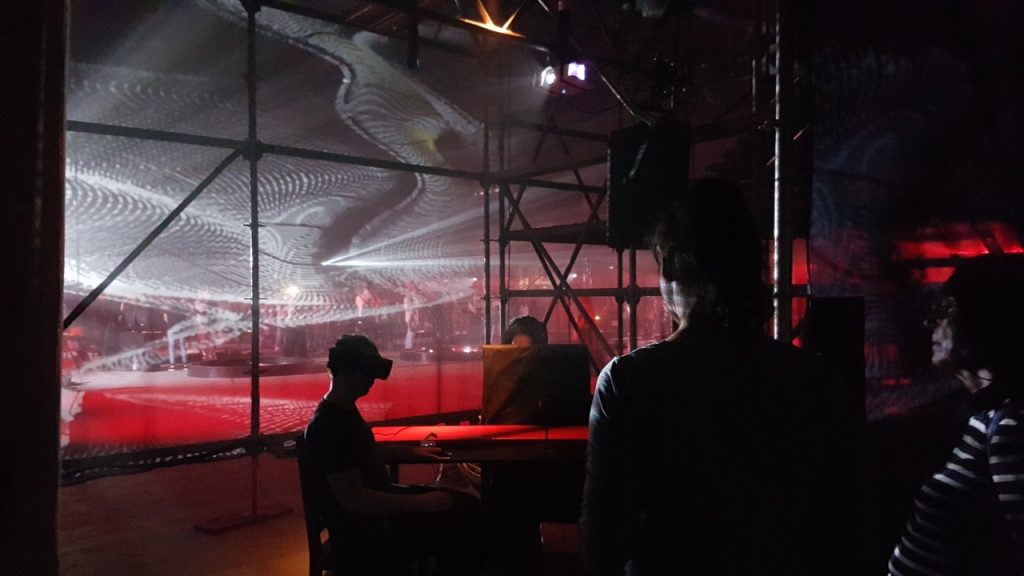
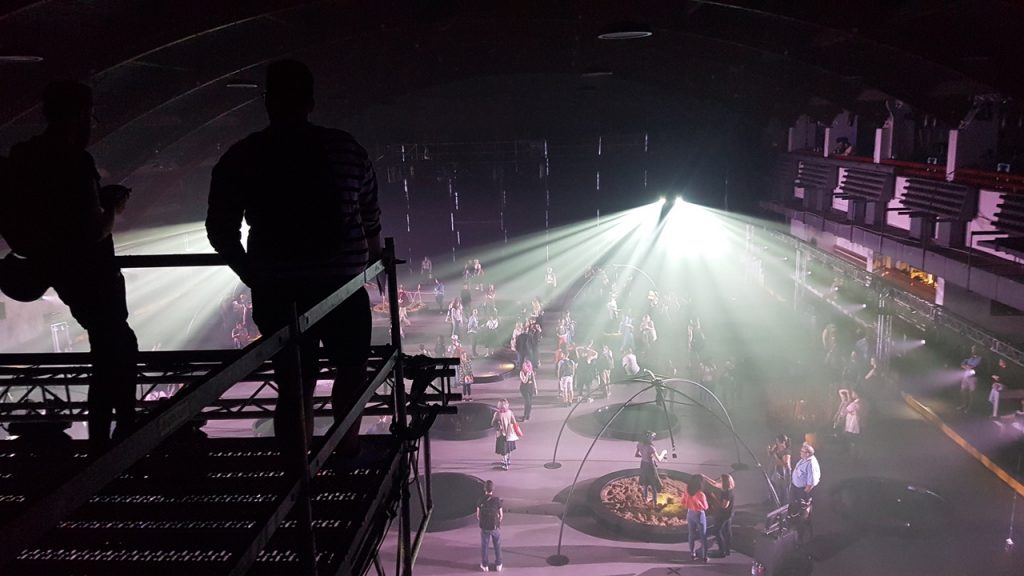

Prague Quadrennial’s 36Q˚ (pronounced “threesixty”) presents the artistic and technical side of performance design concerned with creation of active, sensorial and predominantly nontangible ironments. Just like a performer, these emotionally charged environments follow a certain dramatic structure, change and evolve in time and invite our visitors to immerse themselves in a new experience.
WORKSHOPS, MASTERCLASSES
Curated by Markéta Fantová and Jan K. Rolník
8 – 16 June
Small Sports Hall
Our global society seems to be obsessed with fast paced progress of technology and elevates rational intellectual and scientific pursuits above arts that are intuitive and visceral in their nature. And yet creative minds based in the arts are proving that the boundless imagination paired with new technological advancements often result in original and highly inspiring mind-expanding projects. Even though performance design doesn’t need to use modern technology and is often the most inspiring when it uses simple human interaction, we need to explore and experiment with wide range of possibilities new technologies have to offer. PQ Artistic Director Marketa Fantova established 36Q˚ with those thoughts in mind and with a focus on the young, emerging generation of creatives.
Blue Hour
An experimental, interactive environment that fills the entire space of the Industrial Palace Sports Arena will welcome visitors on 8 June and remain open until the end of PQ 2019. The project, based on intensive team work that brings together experienced artists with emerging designers to collaboratively create, will be led by renowned French visual new media artist Romain Tardy. The curatorial team seeks to experiment with the shifting boundaries between the “non-material” or “virtual” and the “real” world, to explore the capacity of performance design to enlist technology in cultural production.
See more here
Invited lecture and a collaboration meeting with professor Iiro P Jääskeläinen and Enactive Virtuality Lab May 21-22, 2019.
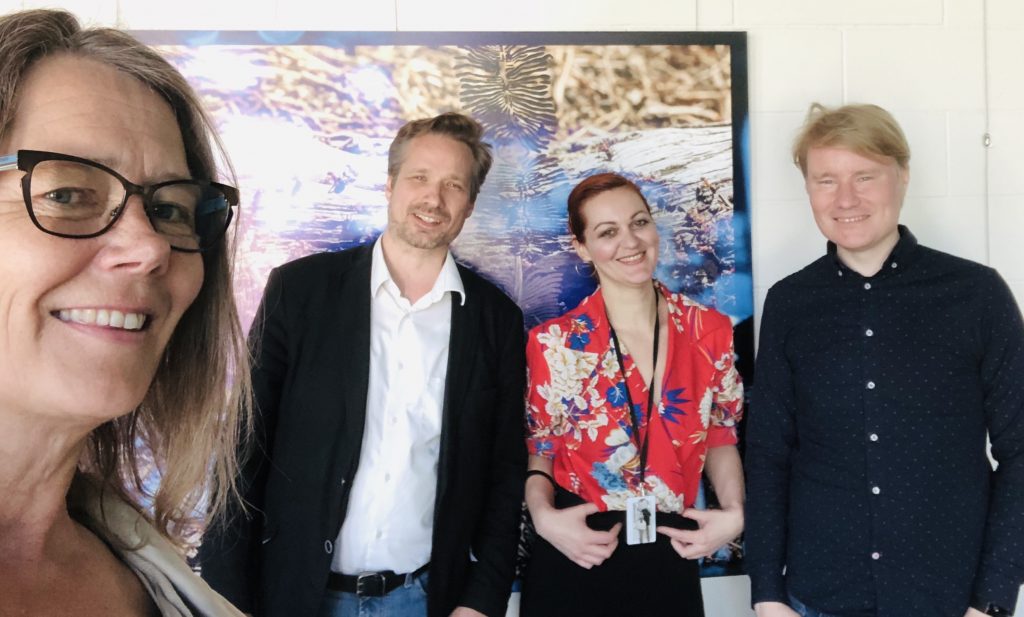
Image: Pia Tikka, Iiro P Jääskeläinen, Jelena Rosic, and Ilkka Kosunen at MEDIT meeting space.
May 21 at 3-4 pm Dr Iiro P. Jääskeläinen, Associate Professor of the Brain and Mind Laboratory, Department of Neuroscience and Biomedical Engineering, Aalto University School of Science, Finland,
gave an open neurocinematic talk on “Using movies as real-life like stimuli during neuroimaging to study the neural basis of social cognition” (room M-134).
Abstract:
Movies and narratives are increasingly used as stimuli in neuroimaging studies. This in many ways helps bridge the gaps between neuroscience, psychology, and even social sciences by allowing stimulation of, and thus also measurement of neural activity underlying, phenomena that have been less amenable to study with more traditional neuroimaging stimulus-task designs. Observation of signature patterns underlying discrete emotions across largely shared brain structures have suggested that both basic and dimensional emotion theories are partly correct. Robust differences in brain activity when viewing genetic vs. adopted sisters going through a moral dilemma in a movie clip have shown that knowledge of shared genes shapes perception of social interactions, thus demonstrating how neuroimaging can offer important measures for social sciences that complement the traditional behavioral ones. Furter, more idiosyncratic brain activity has been observed in high-functioning autistic than neurotypical subjects specifically in putative social brain regions when watching a drama movie. Development of data analysis algorithms holds keys to rapid advances in this relatively new area of research. Modeling the stimulus and recording brain activity is significantly complemented by behavioral measures on how the subjects experienced the movie stimulus.
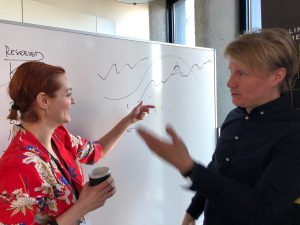

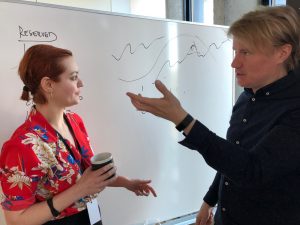

Image: Jelena Rosic and Ilkka Kosunen engaged in discussing correlations between ‘pheno’-dynamics and ‘neuro’-dynamics for our micro-phenomenological Memento study, a follow-up for Kauttonen et al 2018.

Invited talk on “Narrative Sense-Making – A Neurocinematic Approach” at the Max Planck Institute for Empirical Aesthetics (MPI), Frankfurt am Main, March 26, 2019.
Presentation at the Cinema of the Deutsches Filminstitut & Filmmuseum, Frankfurt am Main, Brain on the Screen public series of 4 introductory talks: Ed Vessel, Vittorio Gallese, Marie Therese Forster, and Pia Tikka.

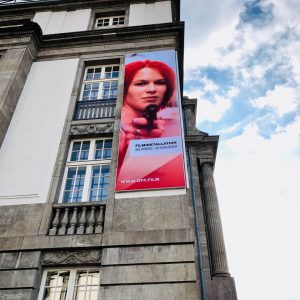
Run Lola Run (German: Lola rennt) is a 1998 German thriller film written and directed by Tom Tykwer, and starring Franka Potente as Lola and Moritz Bleibtreu as Manni. The story follows a woman who needs to obtain 100,000 Deutsche Mark in twenty minutes to save her boyfriend’s life.
The Brain on Screen
Diese und weitere Fragen stehen im Zentrum der Film- und Vortragsreihe „The Brain on Screen“, die das Max-Planck-Institut für empirische Ästhetik gemeinsam mit dem Deutschen Filminstitut & Filmmuseum im März 2019 veranstaltet. An vier Dienstagen (5., 12., 19. und 26.03.2019) werden vier Experten jeweils eine Einführung in vier Filme geben, die aus neurowissenschaftlicher Perspektive interessant sind.
Während der anschließenden Filmvorführung hat das Publikum die Gelegenheit, hautnah mitzuerleben, wie neurowissenschaftliche Forschung zum Filmerleben aussehen kann. Wer möchte, kann Teilnehmer in einer den Film begleitenden Studie werden.

„The Brain on Screen“ bietet einen wissenschaftlichen und praktischen Einblick in ein spannendes Forschungsfeld und verwandelt das Gehirn selbst in einen Akteur.
Wenn Sie Interesse haben teilzunehmen, können Sie sich hier anmelden.
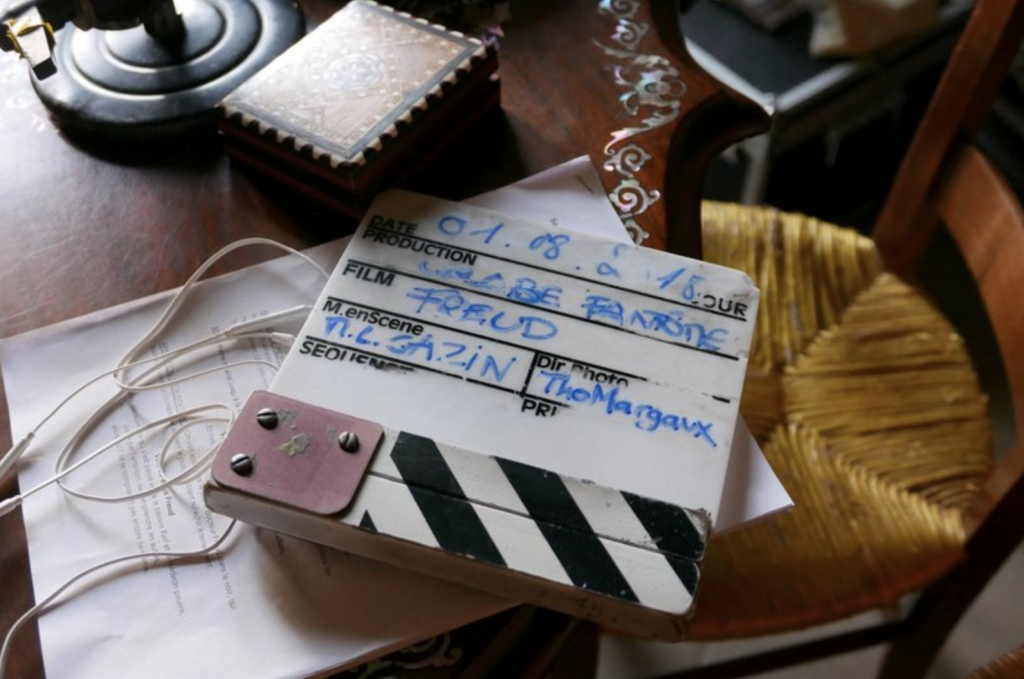
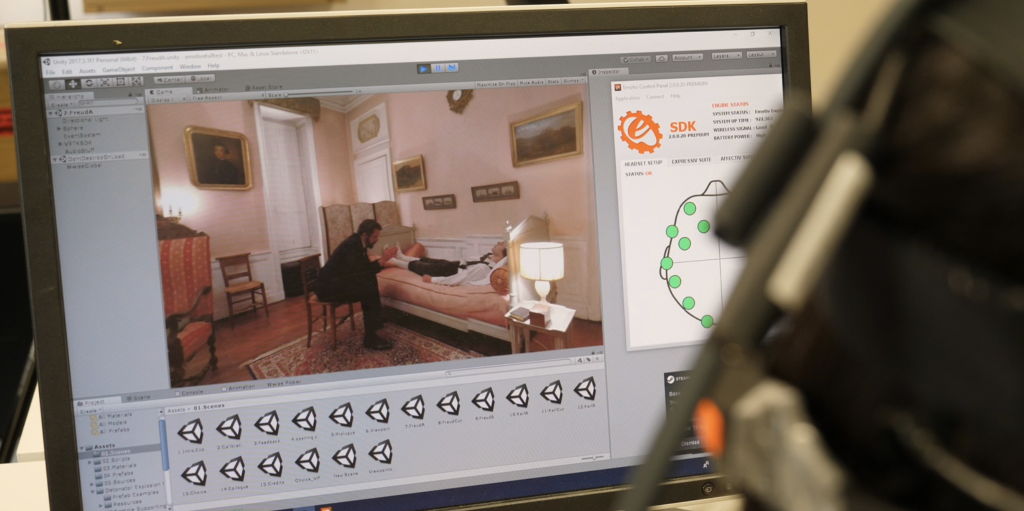
Presentation of the ongoing project Emotive VR prototype, an innovative form combining VR and EEG headsets. A neuro-interactive omnidirectional movie has been realized, visualized in Virtual Reality (VR) Head-Mounted Display (HMD). During the visualization, the EEG signals are recorded and analyzed in real time. Some visual effects and an interactive music vary according to the emotional state of the viewer.
Marie-Laure Cazin is a Fine Arts teacher in the High school of Arts and Design ESAD-TALM (France) and in Paris 1 Panthéon-Sorbonne. Part of the Enactive Virtuality Research Group, in BFM, University of Talinn, she is currently completing a PhD in Aix-Marseille University (France) on Cinema and Neurosciences. As an artist and a filmmaker, she has developed many experimental cinematic prototypes, using digital tools to create a live interaction between the film and performers or spectators. She collaborated with scientists for art-science projects, working with brains’ datas of emotions in her last interactive projects.
See projects on line (Fr)
Sound designer Matias Harju webpages (Eng)
EMOTIVE VR documentation online (Fr)
2 TALKS on EMOTIVE VR by Marie-Laure Cazin (ESAD-TALM, France)
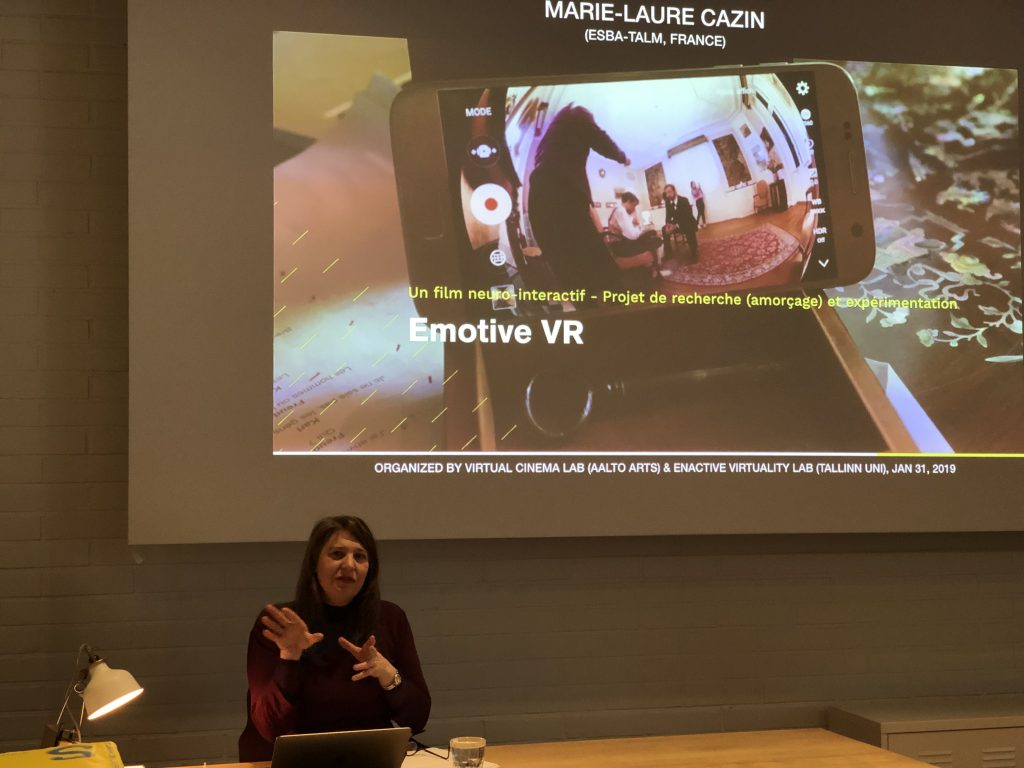
Visiting lecture at Aalto University, Aalto Studios, organised by Virtual Cinema Lab & Enactive Virtuality Lab, January 30, at 14-15
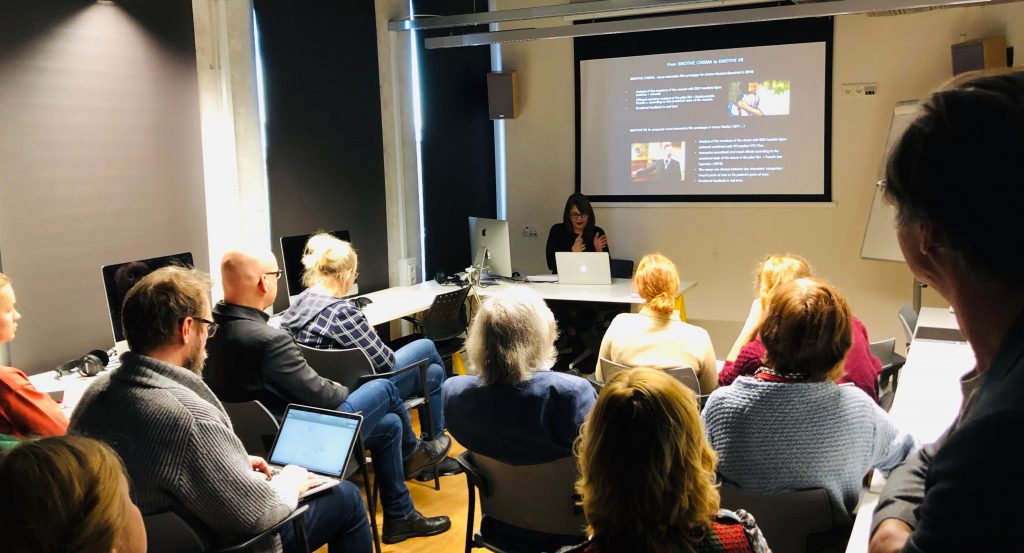
January 30, at 14-15 Place: N-416, BFM, Narva Mnt 27, Nova Building, Tallinn University.
The chief editor Douglas Rosenberg is very excited to share the news:

The Oxford Handbook of Screendance Studies has been awarded the 2018 Oscar G. Brockett Book Prize for Dance Research by The Dance Studies Association.
The following is the citation offered by the selection committee about the book:
The Oxford Handbook of Screendance Studies, which is skillfully edited by Douglas Rosenberg, features a gracefully comprehensive introduction and thirty-six impactful chapters from leading scholars who expand our understanding of screen technologies as creative, collaborative tools for dance. Both foundational and insightful, the essays focus on pioneering figures like Loie Fuller, Maya Deren, and Norman McLaren; on histories from Harlem and Hollywood to Brazil and Bollywood; and on themes that productively intertwine virtual bodies, framing, editing, space, race, gender, and politics. Authors from Dance Studies and related fields turn their gazes toward the way screendance can provide a liberating or controlled space, an ever-changing canvas, a democratic frontier, a site for social justice, new aesthetic pleasure, or a viral phenomenon with many meanings. Readable, rigorous, and thought-provoking, The Oxford Handbook of Screendance Studies engages popular, contemporary, traditional, and historical dance, offering wide-ranging new ways of understanding how ideas travel and can transform our lives through the “stage” of the screen.
The award will be conferred at the annual Dance Studies Association Conference at Northwestern University, August 8 – 11, 2019.
The Oxford Handbook of Screendance Studies is the first publication to offer a scholarly overview of the histories, practices, and critical and theoretical foundations of the rapidly changing landscape of screendance.
Pia Tikka & Mauri Kaipainen contributed with the chapter on “Screendance as Enactment in Maya Deren’s At Land: Enactive, Embodied, and Neurocinematic Considerations”